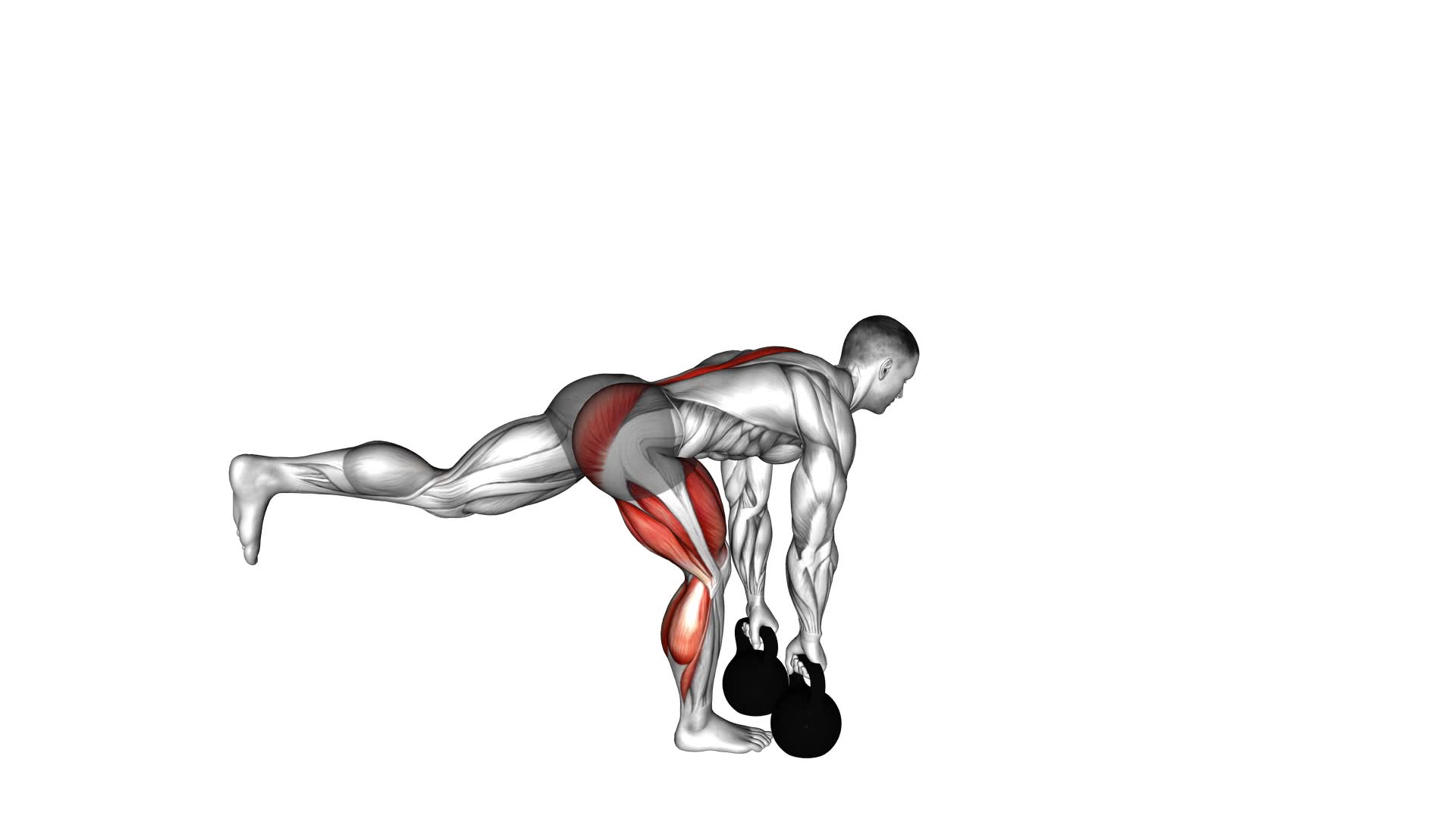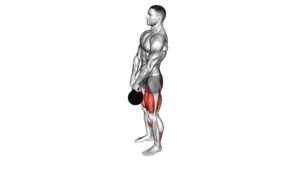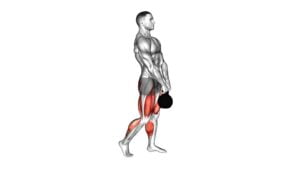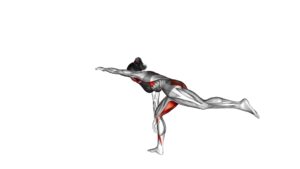Kettlebell Single Leg Deadlift – Video Exercise Guide & Tips

Are you looking for a challenging exercise that targets your lower body? Look no further than the kettlebell single leg deadlift!
Watch This Exercise Video
In this video exercise guide, we will show you the proper form and technique to perform this exercise effectively.
You'll also learn about common mistakes to avoid and variations to keep things interesting.
By following our tips, you can maximize your results and take your fitness to the next level.
Let's get started!
Key Takeaways
- Kettlebell single leg deadlift improves balance and targets glutes and hamstrings.
- Proper form and technique include starting with proper foot placement, keeping the back straight, and engaging the glutes and hamstrings.
- Common mistakes to avoid include allowing the knee to collapse inward, rounding the back, and rushing the movement.
- Variations and progressions include elevated single leg deadlift, kettlebell swing single leg deadlift, and single arm kettlebell single leg deadlift.
Benefits of Kettlebell Single Leg Deadlift
You can experience numerous benefits by incorporating the kettlebell single leg deadlift into your workout routine. This exercise is highly effective in improving balance and targeting your glutes and hamstrings.
One of the main advantages of the kettlebell single leg deadlift is its ability to enhance your balance. By performing this exercise on one leg, you engage your stabilizer muscles, which help you maintain stability and control throughout the movement. This can be particularly beneficial for athletes or individuals looking to improve their overall balance and coordination.
Additionally, the kettlebell single leg deadlift specifically targets your glutes and hamstrings. As you hinge forward and lift the kettlebell, your glutes and hamstrings have to work together to stabilize and control the movement. This not only helps to strengthen these muscle groups but also improves their overall function and performance.
Incorporating the kettlebell single leg deadlift into your workout routine can be a great way to improve your balance and target your glutes and hamstrings. However, it's important to ensure proper form and technique to maximize the benefits and prevent injury.
Proper Form and Technique
To execute the kettlebell single leg deadlift with proper form and technique, focus on maintaining a stable and controlled movement throughout. Here are some key tips to ensure proper alignment and avoid common errors:
- Start with proper foot placement: Stand tall with your feet hip-width apart. Engage your core and slightly bend your knee on the supporting leg.
- Keep your back straight: Throughout the movement, maintain a neutral spine, avoiding any rounding or arching of the back. This helps to protect your lower back and maintain proper alignment.
- Engage your glutes and hamstrings: As you hinge forward from the hips, focus on squeezing your glutes and hamstrings to drive the movement. This will help to activate the posterior chain and maintain stability.
Common errors to watch out for include:
- Allowing your knee to collapse inward: Keep your knee in line with your toes to avoid any unnecessary stress on the joint.
- Rounding your back: Maintain a flat back throughout the movement to prevent strain on your spine.
- Rushing the movement: Take your time and focus on the quality of each repetition. Avoid using momentum to swing the kettlebell up.
Common Mistakes to Avoid
One common mistake to avoid when performing the kettlebell single leg deadlift is allowing your knee to collapse inward. This can put unnecessary strain on your knee joint and increase the risk of injury.
To prevent this mistake, focus on maintaining proper alignment throughout the movement. Start by standing tall with your feet hip-width apart and your core engaged. As you hinge forward at the hips, keep your back flat and your chest lifted.
Your standing leg should remain slightly bent, while your lifted leg extends straight behind you. Throughout the exercise, make sure to keep your knee in line with your toes, avoiding any inward or outward movement.
By maintaining proper alignment, you can maximize the effectiveness of the exercise while minimizing the risk of injury. It may be helpful to perform the movement in front of a mirror or with a trainer to ensure you're maintaining the correct form.
Variations and Progressions
To continue building strength and challenging your balance, progress the kettlebell single leg deadlift by incorporating variations into your routine. These advanced modifications won't only increase the difficulty of the exercise but also enhance muscle activation. Here are three variations to consider:
- Elevated Single Leg Deadlift: Place your back foot on a step or platform while performing the single leg deadlift. This variation increases the range of motion and forces your stabilizing muscles to work even harder.
- Kettlebell Swing Single Leg Deadlift: Start with a kettlebell swing and transition into a single leg deadlift. This combination adds an explosive element to the exercise, enhancing power and coordination.
- Single Arm Kettlebell Single Leg Deadlift: Hold the kettlebell in one hand while performing the single leg deadlift. This variation challenges your core stability and upper body strength as you work to maintain balance.
By incorporating these variations into your routine, you'll continue to challenge your body and further enhance your strength and balance.
Now, let's move on to the next section to learn some tips for maximizing your results.
Tips for Maximizing Results
To maximize your results, focus on proper form and technique while performing the kettlebell single leg deadlift. This exercise can be highly effective when done correctly, but there are a few common misconceptions that you should be aware of.
Firstly, it's important to note that the recommended weight for this exercise may vary depending on your strength and fitness level. Start with a weight that challenges you without compromising your form. It's better to start lighter and gradually increase the weight as you build strength and stability.
Remember, the key to maximizing your results is maintaining proper form throughout the movement. Keep your back straight, engage your core, and hinge at the hips as you lower the kettlebell towards the ground. Avoid rounding your back or bending at the waist, as this can put unnecessary strain on your lower back.
Additionally, be mindful of your balance and stability while performing the exercise on one leg. If needed, use a support or perform the exercise near a wall for added stability.
Frequently Asked Questions
What Are the Primary Muscles Targeted in the Kettlebell Single Leg Deadlift?
The primary muscles targeted in the kettlebell single leg deadlift are your glutes, hamstrings, and lower back. This exercise is great for strengthening your posterior chain and improving balance.
If you're a beginner or have limited mobility, you can modify the exercise by using a lighter kettlebell or performing the movement without any weight.
Remember to maintain proper form and engage your core throughout the exercise to maximize its benefits.
Can the Kettlebell Single Leg Deadlift Be Modified for Beginners or Individuals With Limited Mobility?
Yes, the kettlebell single leg deadlift can be modified for beginners or individuals with limited mobility. Modified variations of this exercise can include using a lighter kettlebell or even just bodyweight. These modifications can help you gradually build strength and stability in your legs and core.
Additionally, the kettlebell single leg deadlift offers great benefits for older adults, as it helps improve balance and coordination, which are important for overall functional fitness.
How Often Should the Kettlebell Single Leg Deadlift Be Incorporated Into a Workout Routine?
To maximize the benefits of the kettlebell single leg deadlift, it's important to incorporate it into your workout routine regularly. By doing this exercise at least two to three times a week, you can improve your balance, strengthen your core and lower body muscles, and enhance overall stability.
The frequency of incorporation depends on your fitness level and goals, but consistency is key to seeing progress. So, make sure to add this exercise to your routine and reap the rewards!
Are There Any Specific Breathing Techniques That Should Be Used During the Kettlebell Single Leg Deadlift?
During the kettlebell single leg deadlift, it's important to focus on your breathing techniques. Proper breathing can help stabilize your core and maintain balance throughout the movement. As you lower the kettlebell, exhale and engage your core muscles. Then, inhale as you return to the starting position.
Remember to breathe deeply and rhythmically to enhance your performance. Beginners with limited mobility can modify the exercise by using lighter weights or performing the movement without a kettlebell.
Can the Kettlebell Single Leg Deadlift Help Improve Balance and Stability?
Improving balance and stability through the kettlebell single leg deadlift is possible. This exercise specifically targets the muscles involved in maintaining balance and stability, such as the glutes and core. It helps strengthen these areas, which can improve your overall balance and stability.
For beginners or individuals with limited mobility, there are variations of the kettlebell single leg deadlift that can be performed, such as using a lighter weight or performing the exercise with both feet on the ground.
Conclusion
In conclusion, the kettlebell single leg deadlift is a highly effective exercise that can help improve balance, strengthen the lower body, and enhance overall athletic performance.
By maintaining proper form and technique, avoiding common mistakes, and gradually progressing with variations, you can maximize your results from this exercise.
Remember to consult with a fitness professional if you have any concerns or questions.
Start incorporating the kettlebell single leg deadlift into your workout routine for a stronger and more resilient body.

Author
Years ago, the spark of my life’s passion ignited in my mind the moment I stepped into the local gym for the first time. The inaugural bead of perspiration, the initial endeavor, the very first surge of endorphins, and a sense of pride that washed over me post-workout marked the beginning of my deep-seated interest in strength sports, fitness, and sports nutrition. This very curiosity blossomed rapidly into a profound fascination, propelling me to earn a Master’s degree in Physical Education from the Academy of Physical Education in Krakow, followed by a Sports Manager diploma from the Jagiellonian University. My journey of growth led me to gain more specialized qualifications, such as being a certified personal trainer with a focus on sports dietetics, a lifeguard, and an instructor for wellness and corrective gymnastics. Theoretical knowledge paired seamlessly with practical experience, reinforcing my belief that the transformation of individuals under my guidance was also a reflection of my personal growth. This belief holds true even today. Each day, I strive to push the boundaries and explore new realms. These realms gently elevate me to greater heights. The unique combination of passion for my field and the continuous quest for growth fuels my drive to break new ground.



